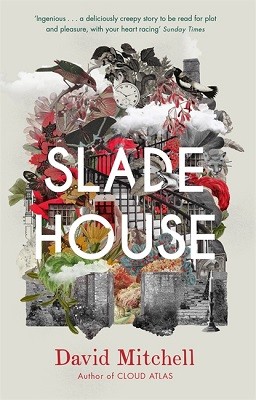Slade House by David Mitchell
 I’ve been told that Slade House is shorter and simpler than
David Mitchell’s other work – a sort of Mitchell Lite companion volume to The
Bone Clocks, and also full of references to characters in the rest of his
books. However, Slade House is the only one of Mitchell’s books I’ve read, so I
can only judge it as a standalone novel.
I’ve been told that Slade House is shorter and simpler than
David Mitchell’s other work – a sort of Mitchell Lite companion volume to The
Bone Clocks, and also full of references to characters in the rest of his
books. However, Slade House is the only one of Mitchell’s books I’ve read, so I
can only judge it as a standalone novel.
I would describe Slade House as a horror novel, albeit a
relatively literary, thoughtful one, and not one that I personally found
frightening.
Slade House itself is a mysterious residence which only seems to
be accessible every nine years, when a featureless doorway appears in an alley
way to particular individuals. What they find there differs from person to
person, and seems to be tailored to their particular needs. A lonely boy who
struggles to fit in with others finds a friend of his own age who doesn’t think
he’s a weirdo, while his mother, a musician, is introduced to Yehudi Menuhin. A
recently divorced policeman is seduced by a beautiful woman, and a shy student
bullied about her weight seems about to begin a romance with the very boy she’s
long admired from afar. What really lies behind the shifting façade of Slade
House, and who are the mysterious brother and sister who appear in different
incarnations each time the house appears?
Each character’s section of the narrative has echoes of the
one before it, and each character seems to suffer a similar fate which means
the plot is by its very nature episodic and somewhat repetitive. The characters
themselves are engaging enough to keep things interesting, with each one being
a believable victim. Some are likeable (the young boy at the start) and others
less so (the wife-beating copper). Each is very much of a type and, as such,
perhaps lacking in complexity, but the nature of the plot means we have to get
the measure of them in a very short time so I think this actually works
successfully.
Less successful, for me, are Norah and Jonah, the brother
and sister behind the evils of Slade House, and their back story. Far too often
Mitchell has them deliver exposition by telling one another things in great
detail that they would already know, and while I suspect this is intended to be
pastiche; I don’t think it works. Their history is largely explained in a
single chunk towards the end of the story and is the least interesting thing in
the book. When it comes to humour and horror, Slade House is best when it’s
subtle rather than over-the-top.
Comments
Post a Comment